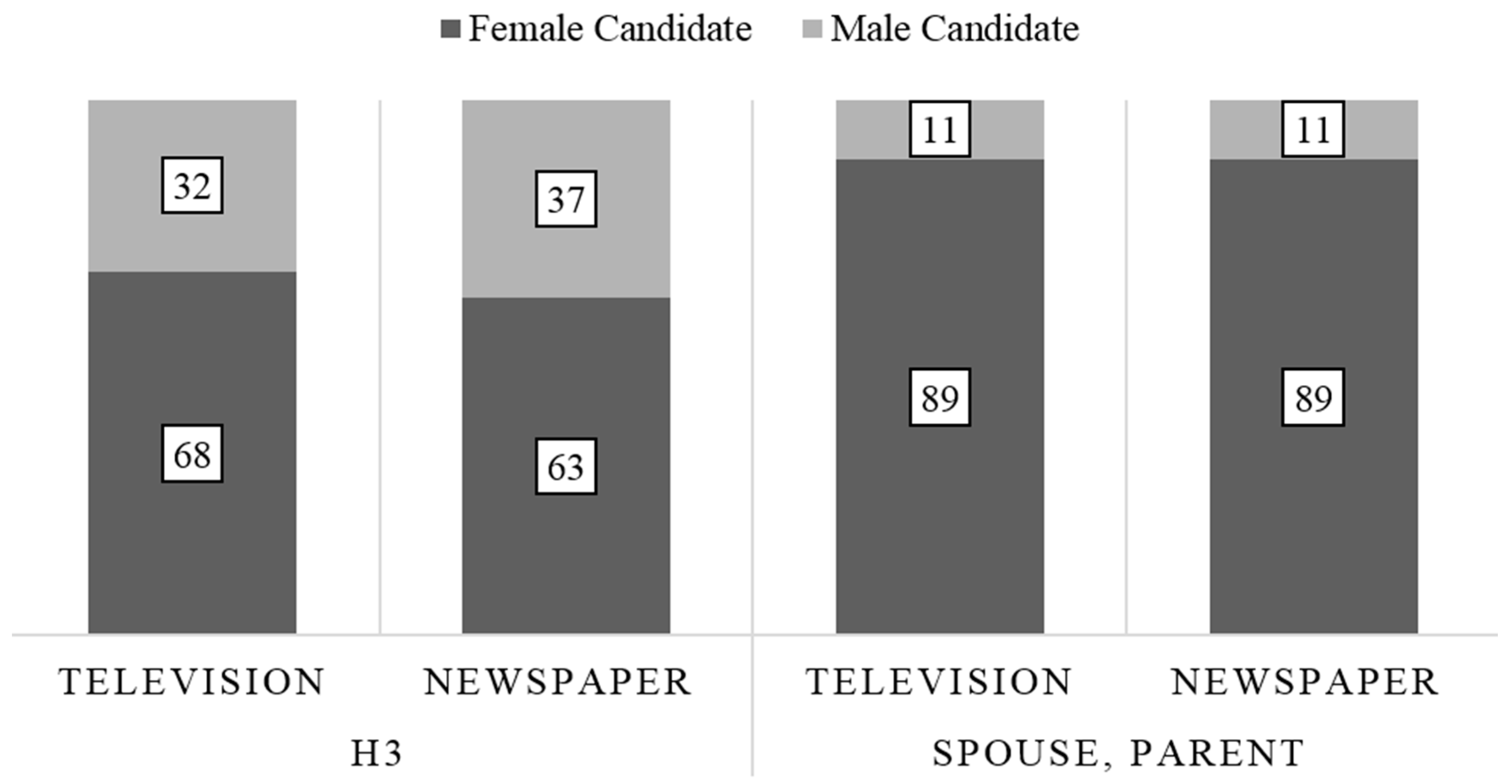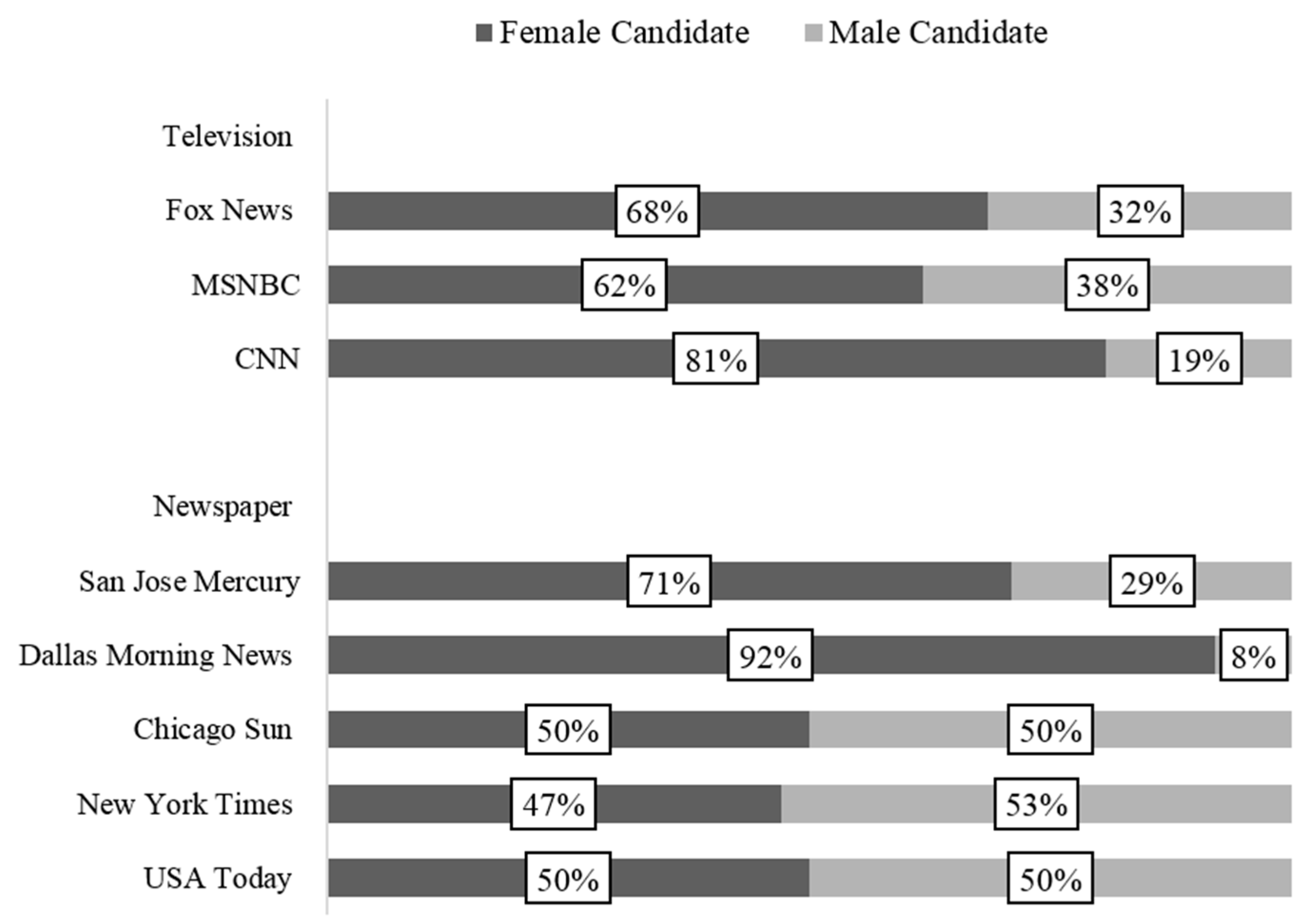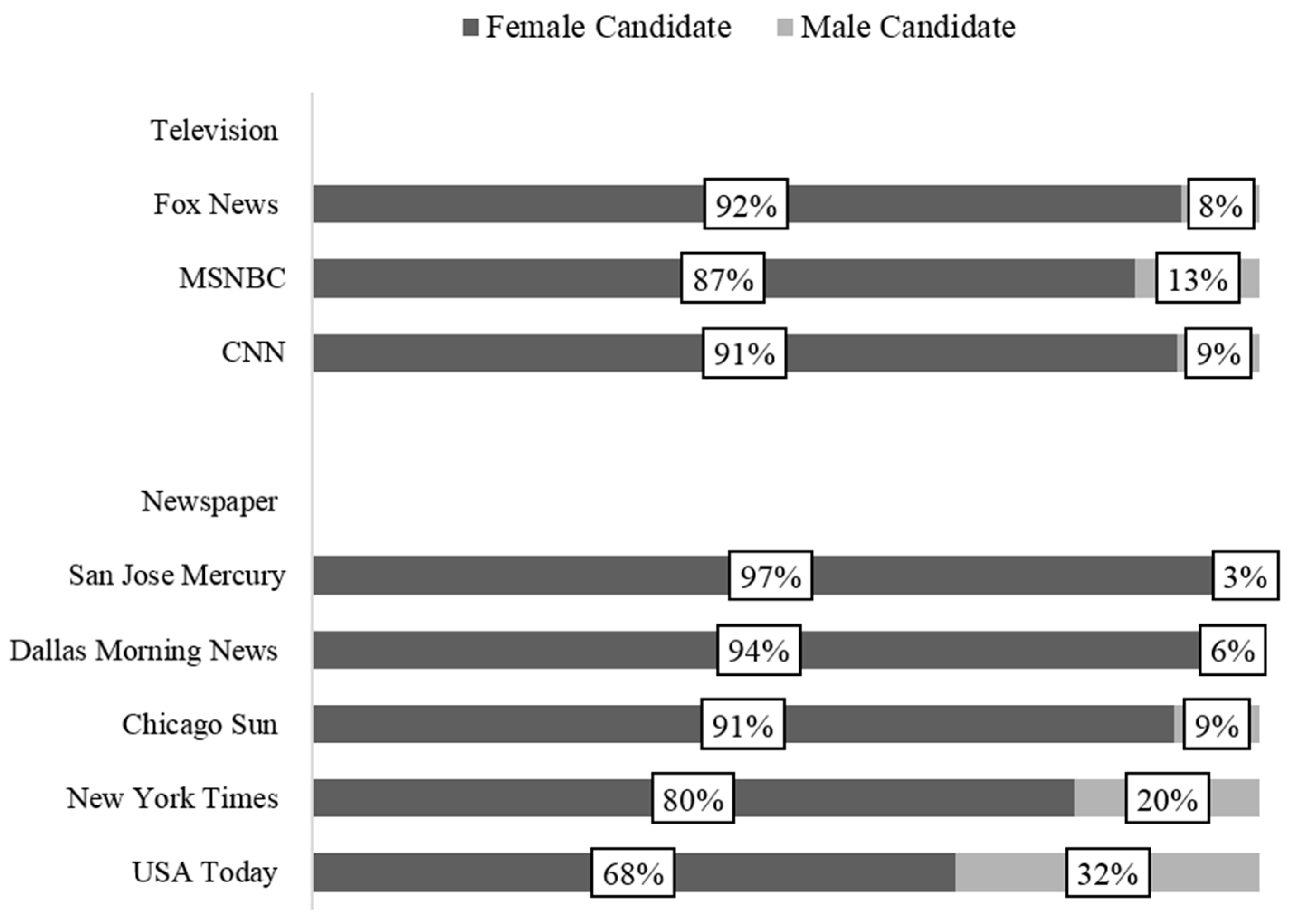18 Million Cracks, but No Cigar: News Media and the Campaigns of Clinton, Palin, and Bachmann
Abstract
:1. Introduction
2. Why Women? And Why Not?
3. Contemporary Media Priming
4. Data and Methods
4.1. Sample
4.2. Coding Methods
5. Results
6. Discussion
7. Conclusions
Author Contributions
Conflicts of Interest
References and Notes
- Center for American Women and Politics. “Current Numbers.” 2015. Available online: http://cawp.rutgers.edu/current-numbers (accessed on 2 February 2016).
- Jay Newton-Small. “Women are the Only Adults Left in Washington.” Time Magazine. 16 October 2013. Available online: http://swampland.time.com/2013/10/16/women-are-the-only-adults-left-in-washington/ (accessed on 12 January 2016).
- Jonathan Weisman, and Jennifer Steinhauer. “Senate Women Lead in Effort to Find Accord.” New York Times. 15 October 2013. Available online: http://www.nytimes.com/2013/10/15/us/senate-women-lead-in-effort-to-find-accord.html (accessed on 14 October 2013).
- Laura Bassett. “Men Got Us into the Shutdown, Women Got Us Out.” Huffington Post. 2013. Available online: http://www.huffingtonpost.com/2013/10/16/shutdown-women_n_4110268.html (accessed on 16 October 2013).
- Amanda Marcotte. “House Republicans Give 20 Out of 21 Committee Chairs to Men.” Slate. 20 November 2014. Available online: http://www.slate.com/blogs/xx_factor/2014/11/20/women_in_congress_house_gop_gives_20_out_of_21_committee_chairs_to_men.html (accessed on 12 January 2016).
- Igor Bobiz. “Male Senator’s Never Seen Sexism in the Senate, Thinks Kirsten Gillibrand Should Name Names.” Huffington Post. 2014. Available online: http://www.huffingtonpost.com/2014/09/03/ron-johnson-gillibrand_n_5759790.html (accessed on 2 September 2014).
- Maya Rhodan. “Senator Says Male Colleague Told Her ‘You’re Even Pretty When You’re Fat.” Time Magazine. 27 August 2014. Available online: http://time.com/3197103/kirsten-gillibrand-senate-sexism/ (accessed on 21 December 2015).
- Sean Aday, and James Devitt. “Style Over Substance: Newspaper Coverage of Elizabeth Dole’s Presidential Bid.” Harvard International Journal of Press/Politics 6 (2001): 52–61. [Google Scholar] [CrossRef]
- Johanna Dunaway, Regina G. Lawrence, Melody Rose, and Christopher R. Weber. “Traits versus Issues: How Female Candidates Shape Coverage of Senate and Gubernatorial Races.” Political Research Quarterly 66 (2013): 715–26. [Google Scholar] [CrossRef]
- Melissa K. Miller, and Jeffrey S. Peake. “Press Effects, Public Opinion, and Gender: Coverage of Sarah Palin’s Vice-Presidential Campaign.” International Journal of Press/Politics 18 (2013): 482–507. [Google Scholar] [CrossRef]
- Marie Wilson. Closing the Leadership Gap: Why Women Can and Must Help Run the World. New York: Viking Press, 2004. [Google Scholar]
- Kathleen Dolan. When Does Gender Matter? Women Candidates and Gender Stereotypes in American Elections. Oxford: Oxford University Press, 2014. [Google Scholar]
- Danny Hayes. “When Gender and Party Collide: Stereotyping in Candidate Trait Attribution.” Politics & Gender 7 (2011): 133–65. [Google Scholar] [CrossRef]
- Deborah Jordan Brooks. He Runs, She Runs: Why Gender Stereotypes Do Not Harm Women Candidates. Princeton: Princeton University Press, 2013. [Google Scholar]
- Danny Hayes, Jennifer Lawless, and Gail Baitinger. “Who Cares What They Wear? Media, Gender, and the Influence of Candidate Appearance.” Social Science Quarterly 95 (2014): 1194–212. [Google Scholar] [CrossRef]
- Danny Hayes, and Jennifer Lawless. “A Non-Gendered Lens? Media, Voters and Female Candidates in Contemporary Congressional Elections.” Perspectives on Politics 13 (2015): 95–118. [Google Scholar] [CrossRef]
- Nichole M. Baur. “Emotional, Sensitive, and Unfit for Office? Gender Stereotype Activation and Support Female Candidates.” Political Psychology 36 (2015): 691–708. [Google Scholar] [CrossRef]
- Georgia Duerst-Lahti. “Presidential Elections: Gendered Space and the Case of 2004.” In Gender and Elections: Shaping the Future of American Politics. Edited by Susan J. Carroll and Richard L. Fox. Cambridge: Cambridge University Press, 2006, pp. 12–42. [Google Scholar]
- Inter-Parliamentary Union, and UN Women. “Women in Politics: 2015.” 2015. Available online: http://www.ipu.org/english/surveys.htm#MAP2015 (accessed on 11 January 2016).
- Kathleen A. Bratton, and Leonard P. Ray. “Descriptive Representation, Policy Outcomes, and Municipal Day-Care coverage in Norway.” American Journal of Political Science 46 (2002): 428–37. [Google Scholar] [CrossRef]
- Susan J. Carroll, ed. The Impact of Women in Public Office. Bloomington: Indiana University Press, 2001.
- Mercedes Mateo-Diaz. Representing Women?: Female Legislators in West European Parliaments. Colchester: European Consortium for Political Research Press, 2005. [Google Scholar]
- Pippa Norris. “Women’s Representation and Electoral Systems.” In Encyclopedia of Electoral Systems. Edited by Richard Rose. Washington: CQ Press, 2000. [Google Scholar]
- Leslie A. Schwindt-Bayer. “Still Supermadres? Gender and the Policy Priorities of Latin American Legislators.” American Journal of Political Science 50 (2006): 570–85. [Google Scholar] [CrossRef]
- Michele L. Swers. “Are Women More Likely to Vote for Women’s Issue Bills than Their Male Colleagues? ” Legislative Studies Quarterly 23 (1998): 435–48. [Google Scholar] [CrossRef]
- Sue Thomas. How Women Legislate. Oxford: University Press Oxford, 1994. [Google Scholar]
- Karen Beckwith. “Numbers and Newness: The Descriptive and Substantive Representation of Women.” Canadian Journal of Political Science 40 (2007): 27–49. [Google Scholar] [CrossRef]
- David E. Campbell, and Christina Wolbrecht. “See Jane Run: Women Politicians as Role Models for Adolescents.” The Journal of Politics 68 (2006): 233–47. [Google Scholar] [CrossRef]
- Pew Research Center: Social and Demographic Trends. “Women and Leadership: Public Says Women are Equally Qualified, but Barriers Persist.” 2015. Available online: http://www.pewsocialtrends.org/2015/01/14/women-and-leadership/ (accessed on 12 January 2016).
- Richard L. Fox, and Jennifer Lawless. “Gendered Perceptions and Political Candidacies: A Central Barrier to Women’s Equality in Electoral Politics.” American Journal of Political Science 55 (2011): 59–73. [Google Scholar] [CrossRef]
- Richard L. Fox, and Jennifer Lawless. “Uncovering the Origins of the Gender Gap in Political Ambition.” American Political Science Review 108 (2014): 499–519. [Google Scholar] [CrossRef]
- Kathleen Dolan. “Do Women Candidates Play to Gender Stereotypes? Do Men Candidates Play to Women? Candidate Sex and Issue Priorities on Campaign Websites.” Political Research Quarterly 58 (2005): 31–44. [Google Scholar] [CrossRef]
- Jennifer L. Lawless, and Richard L. Fox. It Still Takes a Candidate. Cambridge: Cambridge University Press, 2005. [Google Scholar]
- Susan Welch. “Women as Political Animals? A Test of Some Explanations for Male-Female Political Participation Differences.” American Journal of Political Science 21 (1977): 711–30. [Google Scholar] [CrossRef]
- Jennifer L. Lawless. Becoming a Candidate. Cambridge: Cambridge University Press, 2012. [Google Scholar]
- Richard L. Fox, and Jennifer Lawless. “If Only They’d Ask: Gender, Recruitment, and Political Ambition.” The Journal of Politics 72 (2010): 310–26. [Google Scholar] [CrossRef]
- Kathleen Hall Jamieson. Beyond the Double Bind: Women and Leadership. Oxford: Oxford University Press, 1995. [Google Scholar]
- Sue Thomas. “Introduction.” In Women and Elective Office: Past, Present, and Future. Edited by Sue Thomas and Clyde Wilcox. New York: Oxford University Press, 2005, pp. 3–25. [Google Scholar]
- Organization for Economic Cooperation and Development. “Employment: Time Spent in Paid and Unpaid Work, by Sex.” 2015. Available online: http://stats.oecd.org/index.aspx?queryid=54757 (accessed on 21 December 2015).
- Kira Sanbonmatsu. Where Women Run: Gender and Party in the American States. Ann Arbor: University of Michigan Press, 2006. [Google Scholar]
- Kira Sanbonmatsu. “Life’s a Party: Do Political Parties Help or Hinder Women? ” Harvard International Review 32 (2010): 36–39. [Google Scholar]
- Cecilia Hyunjung Mo. “The Consequences of Explicit and Implicit Gender Attitudes and Candidate Quality in the Calculations of Voters.” Political Behavior 37 (2015): 357–95. [Google Scholar] [CrossRef]
- Jennifer L. Lawless, and Kathryn Pearson. “The Primary Reason for Women’s Underrepresentation? Reevaluating the Conventional Wisdom.” Journal of Politics 70 (2008): 67–82. [Google Scholar] [CrossRef]
- Barbara Palmer, and Dennis Simon. Breaking the Political Glass Ceiling: Women and Congressional Elections. New York: Routledge, Taylor and Francis Group, 2006. [Google Scholar]
- Sarah A. Fulton. “Running Backwards and in High Heels: The Gendered Quality Gap and Incumbent Electoral Success.” Political Research Quarterly 65 (2012): 303–14. [Google Scholar] [CrossRef]
- Caroline Heldman, Susan Carroll, and Stephanie Olson. “She Brought only a Skirt: Print Media Coverage of Elizabeth Dole’s Bid for the Republican Presidential Nomination.” Political Communication 22 (2005): 315–35. [Google Scholar] [CrossRef]
- Karrin Vasby Anderson. “‘Rhymes with blunt’: Pornification and U.S. political culture.” Rhetoric and Public Affairs 14 (2011): 327–68. [Google Scholar] [CrossRef]
- Erica Falk. Women for President: Media Bias in Nine Campaigns. Chicago: University of Illinois Press, 2010. [Google Scholar]
- Regina G. Lawrence, and Melody Rose. Hillary Clinton’s Race for the White House: Gender Politics and the Media on the Campaign Trail. Boulder: Lynne Rienner Publishers, 2010. [Google Scholar]
- Kim Fridkin Kahn. The Political Consequences of Being a Woman: How Stereotypes Influence the Conduct and Consequences of Political Campaigns. New York: Columbia University Press, 1996. [Google Scholar]
- Patricia Gilmartin. “Still the Angel in the Household: Political Cartoons of Elizabeth Dole’s Presidential Campaign.” Women & Politics 22 (2001): 51–67. [Google Scholar] [CrossRef]
- Maria Braden. Women Politicians and the Media. Lexington: University Press of Kentucky, 1996. [Google Scholar]
- Diane J. Heith. “The Lipstick Watch: Media Coverage, Gender, and Presidential Campaigns.” In Anticipating Madam President. Edited by Robert P. Watson and Ann Gordon. Boulder: Lynne Rienner Publishers, 2013, pp. 123–30. [Google Scholar]
- Kim Fridkin Kahn, and Edie N. Goldenberg. “The Media: Obstacle or Ally of Feminists? ” In Do the Media Govern? Politicians, Voters and Reporters in America. Edited by Shanlo Iyengar and Richard Reeves. Thousand Oaks: Sage Publishing, 1997, pp. 154–74. [Google Scholar]
- Mary C. Banwart, Dianne G. Bystrom, and Terry Robertson. “From the Primary to the General Election: A Comparative Analysis of Candidate Media Coverage in Mixed-gender 2000 Races for Governor and US Senate.” American Behavioral Scientist 46 (2003): 658–68. [Google Scholar] [CrossRef]
- Joan L. Conners. “Barack Versus Hillary: Race, Gender, and Political Cartoon Imagery of the 2008 Presidential Primaries.” American Behavioral Scientist 54 (2010): 298–312. [Google Scholar] [CrossRef]
- Gallup News Service. “Where Americans Turn for Their News.” 2013. Available online: http://www.gallup.com/poll/163412/americans-main-source-news.aspx (accessed on 21 December 2015). Survey conducted 20–24 June 2013.
- Richard L. Fox, and Eric R. A. N. Smith. “The Role of Candidate Sex in Voter Decision-Making.” Political Psychology 19 (1998): 405–19. [Google Scholar] [CrossRef]
- Laura Washington. “Bill Ayers rooting for the protesters.” Chicago Sun-Times, 17 October 2011, Accessed on 23 January 2014 via Newsbank Database. [Google Scholar]
- Richard Roeper. “Politicians Sometimes Can’t Help Tangling with Rabble-Rousers: Responding to a Heckler Rarely Worth Trouble.” Chicago Sun-Times, 17 August 2011, Accessed on 23 January 2014 via Newsbank Database. [Google Scholar]
- O’ Reilly Factor. “How Are Radio Talk Shows Effecting Presidential Politics? ” Fox News Channel, 15 January 2008, Television Transcript accessed on 13 November 2013 via Newsbank Database. [Google Scholar]
- American Morning. “Hurricane Ike Heads to Texas, National Weather Service Issues Dire Warnings; Sarah Palin Gives Her First TV Interview; Queen Noor of Jordan on the U.S. Presidential Race and Building Bridges.” CNN, 12 September 2008, Television Transcript accessed on 12 November 2013 via Newsbank Database. [Google Scholar]
- Kim Firdkin Kahn, and Patrick J. Kenney. The Spectacle of U.S. Senate Campaigns. Princeton: Princeton University Press, 1999. [Google Scholar]
- Slava Mikhaylov, Michael Laver, and Kenneth Benoit. “Coder Reliability and Misclassification in the Human Coding of Party Manifestos.” Political Analysis 20 (2012): 78–91. [Google Scholar] [CrossRef]
- Shauna L. Shames. “The Un-Candidates: Gender and Outsider Signals in Women’s Political Advertising.” Women and Politics 25 (2003): 115–47. [Google Scholar] [CrossRef]
- The Situation Room. “Republicans Prepare For Day Two of Convention.” CNN, 2 September 2008, Television Transcript accessed on 12 November 2013 via Newsbank Database. [Google Scholar]
- Tucker. “For February 8, 2008.” MSNBC, 8 February 2008, Television Transcript accessed on 13 November 2013 via Newsbank Database. [Google Scholar]
- Arlie Hochschild, and Anne Machung. The Second Shift: Working Families and the Revolution at Home. New York: Penguin Books, 2012. [Google Scholar]
- Joan Williams. Unbending Gender: Why Family and Work Conflict and What to Do About it. New York: Oxford Press, 2000. [Google Scholar]
- Tara N. Parsons, and Nicole R. Foster Shoaf. “From Swimsuits to Pant Suits: An Analysis of the 2008 Democratic Presidential Primary.” Virginia Social Science Journal 49 (2014): 29–57. [Google Scholar]
- Pew Research Center for the People and the Press. “A Paradox in Public Attitudes: Men or Women: Who’s the Better Leader? ” 2008. Available online: http://pewsocialtrends.org/files/2010/10/gender-leadership.pdf (accessed on 12 January 2016).
- David S. Pedulla, and Sarah Thébaud. “Can We Finish the Revolution? Gender, Work-Family Ideals, and Institutional Constraint.” American Sociological Review 80 (2015): 116–39. [Google Scholar] [CrossRef] [PubMed]
- Ben Wolfgang. “What Will a Grandchild Mean for Hillary Clinton?: Analysts Debate 2016 Impact.” The Washington Times. 2014. Available online: http://www.washingtontimes.com/news/2014/apr/20/what-will-a-grandchild-mean-for-hillary-clinton/?page=all (accessed on 20 April 2014).



| Source | Clinton | Palin | Bachmann | Total |
|---|---|---|---|---|
| Television Sample Overview | ||||
| CNN | 34 | 33 | 47 | 114 |
| MSNBC | 49 | 50 | 50 | 149 |
| FOX | 49 | 50 | 49 | 148 |
| Total Valid Transcripts | 132 | 133 | 146 | 411 |
| Total # TV Transcripts | 150 | 150 | 150 | 450 |
| Newspaper Sample Overview | ||||
| USA Today | 37 | 47 | 45 | 129 |
| New York Times | 34 | 31 | 37 | 102 |
| Chicago Sun | 25 | 36 | 13 | 67 |
| Dallas Morning News | 17 | 35 | 39 | 91 |
| San Jose Mercury | 36 | 32 | 40 | 108 |
| Total Valid Newspaper Articles | 149 | 181 | 174 | 497 |
| Total # Newspaper Articles | 250 | 250 | 250 | 750 |
| Category | Female Candidates | Male Candidates | Total |
|---|---|---|---|
| # H3 Mentions | 65% (386) | 35%(205) | 100%(591) |
| # Spouse, Parent | 88% (607) | 12%(80) | 100%(687) |
| Chi squared 97.35 (1) p < 0.0001 | |||
| Category | Clinton | Obama | McCain | Palin | Biden | Bachmann | Romney | Total |
|---|---|---|---|---|---|---|---|---|
| # Articles/Transcripts | 400 | 400 | 400 | 1200 | ||||
| # Valid (not excluded) | 281 | 314 | 320 | 915 | ||||
| # H3 Mentions | 30% (53) | 62% (110) | 8% (15) | 88% (297) | 12% (39) | 47% (36) | 53% (41) | 591 |
| # Novelty | 100% (93) | 0% (0) | 0% (0) | 100% (172) | 0% (0) | 100% (50) | 0% (0) | 315 |
| # Spouse, Parent | 89% (278) | 9% (29) | 2% (7) | 93% (278) | 7% (21) | 69% (51) | 31% (23) | 687 |
- 1Clinton 2008: 30 percent of valid articles/transcripts did not include any coded references to the candidates. Of those articles/transcripts that included coded mentions, the article with the most mentions contained 33 separate references, with an average of 5 coded mentions per article/transcript. Just over 22 percent of valid articles/transcripts for the 2008 Palin race included no coded references. Of the articles/transcripts with coded mentions, the article/transcript with the most mentions contained 37 separate references, with an average of 5.3 mentions per article/transcript. The Bachmann race deviated a bit from the 2008 samples. Approximately one quarter of valid articles/transcripts in the 2012 Bachmann race included at least one coded mention, with a maximum of 21 and average of 3.5 coded mentions per article/transcript. Whether this should be attributed to the fact than Bachmann received significantly less coverage than her opponent and the other female candidates in the sample or some other factors driving down H3 coverage is unclear.
© 2016 by the authors; licensee MDPI, Basel, Switzerland. This article is an open access article distributed under the terms and conditions of the Creative Commons Attribution (CC-BY) license (http://creativecommons.org/licenses/by/4.0/).
Share and Cite
Foster Shoaf, N.R.; Parsons, T.N. 18 Million Cracks, but No Cigar: News Media and the Campaigns of Clinton, Palin, and Bachmann. Soc. Sci. 2016, 5, 50. https://doi.org/10.3390/socsci5030050
Foster Shoaf NR, Parsons TN. 18 Million Cracks, but No Cigar: News Media and the Campaigns of Clinton, Palin, and Bachmann. Social Sciences. 2016; 5(3):50. https://doi.org/10.3390/socsci5030050
Chicago/Turabian StyleFoster Shoaf, Nicole R., and Tara N. Parsons. 2016. "18 Million Cracks, but No Cigar: News Media and the Campaigns of Clinton, Palin, and Bachmann" Social Sciences 5, no. 3: 50. https://doi.org/10.3390/socsci5030050
APA StyleFoster Shoaf, N. R., & Parsons, T. N. (2016). 18 Million Cracks, but No Cigar: News Media and the Campaigns of Clinton, Palin, and Bachmann. Social Sciences, 5(3), 50. https://doi.org/10.3390/socsci5030050





